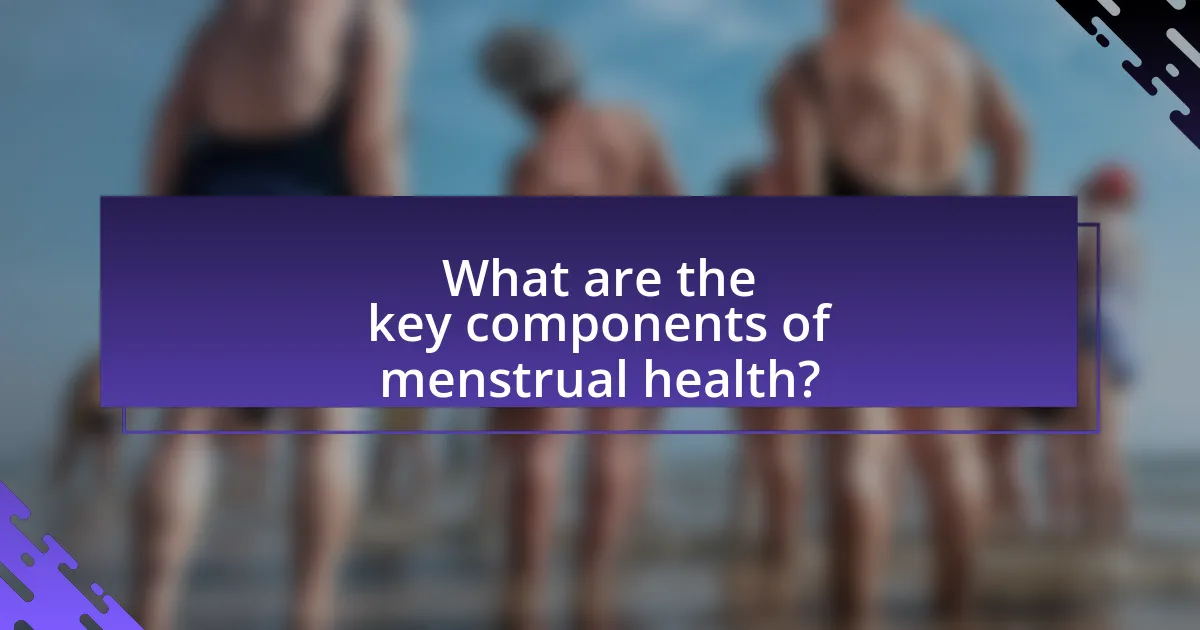Menstrual health is a critical aspect of gender equality, significantly influencing women’s health, education, and economic opportunities. The article explores how inadequate menstrual hygiene management leads to school absenteeism and perpetuates cycles of poverty and inequality, with studies indicating that up to 20% of girls may miss school during their menstrual periods. It discusses the barriers women face, including lack of access to sanitary products, insufficient education, and cultural stigma, which hinder their participation in society. Furthermore, the article highlights the importance of comprehensive menstrual health education, access to hygiene products, and supportive policies in promoting gender equality and improving health outcomes for women.

What is the Role of Menstrual Health in Gender Equality?
Menstrual health plays a crucial role in gender equality by directly impacting women’s health, education, and economic opportunities. When menstrual health is prioritized, it reduces stigma and barriers that prevent women and girls from participating fully in society. For instance, a study by the World Bank found that inadequate menstrual hygiene management can lead to school absenteeism, with girls missing up to 20% of school days due to menstruation. This absence hinders their educational attainment and future job prospects, perpetuating cycles of poverty and inequality. Therefore, addressing menstrual health is essential for empowering women and achieving gender equality.
How does menstrual health impact women’s participation in society?
Menstrual health significantly impacts women’s participation in society by influencing their ability to engage in education, employment, and social activities. Poor menstrual health can lead to absenteeism in schools and workplaces, as studies indicate that up to 20% of girls may miss school during their menstrual periods due to inadequate facilities or stigma. This absence can hinder educational attainment and limit career opportunities, perpetuating gender inequality. Furthermore, societal taboos surrounding menstruation can restrict women’s mobility and participation in public life, reinforcing gender disparities. Research from the World Bank highlights that improving menstrual health can enhance women’s economic participation and overall societal contributions, demonstrating a direct correlation between menstrual health and gender equality.
What barriers do women face regarding menstrual health?
Women face several barriers regarding menstrual health, including lack of access to sanitary products, inadequate education about menstruation, and cultural stigma surrounding menstruation. Access to sanitary products is limited in many low-income areas, with 1 in 10 girls in Africa missing school during their periods due to lack of supplies, according to a report by UNESCO. Additionally, many women receive insufficient education about menstrual health, leading to misinformation and health risks. Cultural stigma often results in social isolation and discrimination, further exacerbating the challenges women face. These barriers significantly impact women’s health, education, and overall gender equality.
How does menstrual health influence educational opportunities for girls?
Menstrual health significantly influences educational opportunities for girls by affecting their attendance and participation in school. Research indicates that inadequate menstrual hygiene management can lead to absenteeism, with studies showing that up to 20% of girls may miss school during their menstrual periods due to stigma, lack of resources, or inadequate facilities. For instance, a study published in the journal “BMC Public Health” found that girls in low-income countries often face barriers such as insufficient access to sanitary products and private sanitation facilities, which directly impacts their ability to attend school consistently. This absenteeism can lead to lower academic performance and increased dropout rates, ultimately hindering gender equality in education.
Why is menstrual health considered a critical aspect of gender equality?
Menstrual health is considered a critical aspect of gender equality because it directly impacts women’s ability to participate fully in society. When menstrual health is neglected, women face barriers such as stigma, lack of access to sanitary products, and inadequate facilities, which can lead to absenteeism in education and employment. According to a study by the World Bank, 1 in 10 girls in Africa misses school during their menstrual cycle, highlighting how menstrual health issues can hinder educational attainment and economic opportunities for women. Addressing menstrual health is essential for empowering women and ensuring their equal participation in all spheres of life.
What are the social stigmas associated with menstruation?
Social stigmas associated with menstruation include beliefs that menstruating individuals are unclean, impure, or incapable of participating in daily activities. These stigmas often lead to social isolation, discrimination, and a lack of access to menstrual hygiene products. For instance, in many cultures, menstruation is considered taboo, resulting in individuals being excluded from religious practices or social gatherings during their menstrual cycle. Research by the World Bank indicates that 1 in 10 girls in Africa miss school during their periods due to stigma and lack of resources, highlighting the significant impact of these social attitudes on education and gender equality.
How do cultural perceptions of menstruation affect gender equality?
Cultural perceptions of menstruation significantly affect gender equality by perpetuating stigma and discrimination against menstruating individuals. In many societies, menstruation is viewed as a taboo subject, leading to the marginalization of women and girls, which can restrict their access to education and employment opportunities. For instance, a study by the World Bank found that in some regions, girls miss school during their menstrual periods due to inadequate sanitation facilities and cultural beliefs that deem menstruation as unclean. This absence from school can lead to lower educational attainment and reduced economic prospects, thereby reinforcing gender inequality. Additionally, negative cultural attitudes towards menstruation can contribute to the lack of support for menstrual health initiatives, further exacerbating disparities in health and social outcomes between genders.

What are the key components of menstrual health?
The key components of menstrual health include access to accurate information, hygiene management, healthcare services, and supportive environments. Access to accurate information ensures individuals understand menstrual cycles, symptoms, and management options, which is crucial for informed decision-making. Hygiene management involves the availability of menstrual products and facilities for safe disposal, which is essential for maintaining health and dignity during menstruation. Healthcare services provide necessary medical support for menstrual-related issues, including pain management and treatment of disorders. Supportive environments encompass societal attitudes and policies that promote menstrual health, reducing stigma and discrimination, which is vital for gender equality. These components collectively contribute to the overall well-being of individuals who menstruate and play a significant role in empowering them within society.
How can access to menstrual hygiene products promote gender equality?
Access to menstrual hygiene products promotes gender equality by enabling individuals who menstruate to manage their periods with dignity and without interruption to their daily activities. When people have reliable access to these products, they are more likely to attend school, participate in the workforce, and engage in social activities, thereby reducing gender disparities in education and employment. For instance, a study by the World Bank found that girls who have access to menstrual hygiene products are 1.5 times more likely to stay in school during menstruation compared to those who do not. This access not only supports physical health but also empowers individuals, fostering a more equitable society where all genders can thrive equally.
What types of menstrual hygiene products are available?
Various types of menstrual hygiene products are available, including pads, tampons, menstrual cups, and period underwear. Pads are absorbent materials worn outside the body, while tampons are inserted into the vagina to absorb menstrual flow. Menstrual cups are reusable silicone or rubber devices that collect menstrual fluid, and period underwear is designed to absorb menstrual flow without additional products. According to a study published in the journal “BMC Women’s Health,” these products cater to different preferences and needs, promoting better menstrual health management and contributing to gender equality by allowing individuals to participate fully in daily activities during menstruation.
How does affordability of these products affect women’s health?
Affordability of menstrual products significantly impacts women’s health by limiting access to necessary hygiene supplies, which can lead to adverse health outcomes. When women cannot afford these products, they may resort to using unsafe alternatives, increasing the risk of infections and other health complications. According to a study published in the journal “BMC Women’s Health,” 1 in 5 women reported missing work or school due to lack of access to menstrual products, highlighting the broader implications on physical and mental health. Furthermore, the World Health Organization emphasizes that inadequate menstrual hygiene management can lead to reproductive health issues, underscoring the critical link between product affordability and women’s overall health.
What role does education play in menstrual health awareness?
Education plays a crucial role in menstrual health awareness by providing individuals with essential knowledge about menstruation, hygiene, and reproductive health. This knowledge empowers individuals to manage their menstrual health effectively, reduces stigma, and promotes informed discussions around menstruation. Research indicates that comprehensive menstrual health education can lead to improved health outcomes, as seen in a study published in the Journal of Adolescent Health, which found that girls who received menstrual health education reported better understanding and management of their menstrual cycles. Furthermore, education fosters gender equality by equipping individuals with the information needed to challenge societal taboos and advocate for their rights related to menstrual health.
How can schools improve menstrual health education?
Schools can improve menstrual health education by integrating comprehensive and age-appropriate curricula that address biological, emotional, and social aspects of menstruation. Research indicates that when schools provide accurate information about menstrual health, students experience reduced stigma and increased confidence, leading to better health outcomes. For instance, a study published in the Journal of Adolescent Health found that comprehensive menstrual health education significantly improved knowledge and attitudes among students, fostering a supportive environment. Additionally, training teachers to deliver this education effectively ensures that students receive consistent and reliable information, further enhancing the impact of the program.
What impact does education have on reducing stigma around menstruation?
Education significantly reduces stigma around menstruation by increasing awareness and understanding of menstrual health. Comprehensive education programs that include information about the biological, social, and cultural aspects of menstruation help dismantle myths and misconceptions. For instance, studies have shown that when students receive accurate information about menstruation, they are less likely to hold negative attitudes towards it, leading to a more supportive environment for menstruators. Research published in the journal “BMC Public Health” indicates that educational interventions can lead to improved attitudes and reduced stigma, highlighting the importance of integrating menstrual health education into school curricula.

What are the global challenges related to menstrual health and gender equality?
Global challenges related to menstrual health and gender equality include stigma, lack of access to menstrual products, inadequate education, and insufficient healthcare services. Stigma surrounding menstruation often leads to discrimination and social exclusion, particularly in low-income countries, where cultural taboos prevent open discussions. According to a study by the World Bank, 1 in 10 girls in Africa misses school during their menstrual cycle due to lack of access to sanitary products, which directly impacts their education and future opportunities. Furthermore, many women and girls lack comprehensive education about menstrual health, leading to misinformation and health risks. Inadequate healthcare services exacerbate these issues, as many women do not receive necessary medical attention for menstrual-related disorders. These interconnected challenges hinder progress toward gender equality by limiting women’s participation in education and the workforce.
How do different countries address menstrual health issues?
Different countries address menstrual health issues through various policies, educational programs, and access to menstrual products. For instance, in India, the government has implemented initiatives like the Menstrual Hygiene Scheme, which aims to provide affordable sanitary products and promote awareness about menstrual health, significantly impacting the lives of millions of women. In contrast, countries like Sweden offer free menstrual products in schools and public facilities, reflecting a commitment to gender equality and health accessibility. Research indicates that these approaches not only improve menstrual health but also contribute to reducing stigma and enhancing educational outcomes for girls, as evidenced by studies from the World Bank and UNICEF.
What policies have been effective in promoting menstrual health?
Policies that have been effective in promoting menstrual health include the implementation of comprehensive menstrual education programs, the provision of free or subsidized menstrual products, and the establishment of supportive workplace policies. Comprehensive menstrual education programs, such as those integrated into school curricula, have been shown to improve knowledge and reduce stigma surrounding menstruation, leading to better health outcomes for individuals. The provision of free or subsidized menstrual products, as seen in countries like Scotland, has increased access and affordability, thereby reducing period poverty and its associated health risks. Supportive workplace policies, including paid menstrual leave, have been adopted in some regions, allowing individuals to manage their menstrual health without economic disadvantage. These policies collectively contribute to improved menstrual health and gender equality by addressing both educational and economic barriers.
How do economic factors influence menstrual health initiatives?
Economic factors significantly influence menstrual health initiatives by determining funding availability, resource allocation, and accessibility of menstrual products. For instance, countries with higher GDPs tend to invest more in public health initiatives, including menstrual health, leading to better education and access to sanitary products. A study by the World Bank in 2020 highlighted that low-income countries often lack the financial resources to implement comprehensive menstrual health programs, resulting in increased stigma and health risks for menstruators. Furthermore, economic disparities can affect the affordability of menstrual products, with many individuals in low-income settings resorting to unsafe alternatives, which can lead to health complications. Thus, economic conditions directly shape the effectiveness and reach of menstrual health initiatives.
What are the health implications of poor menstrual health management?
Poor menstrual health management can lead to significant health implications, including increased risk of reproductive tract infections, menstrual disorders, and mental health issues. Inadequate access to sanitary products and education can result in the use of unhygienic materials, which raises the likelihood of infections such as bacterial vaginosis and urinary tract infections. Furthermore, studies indicate that women experiencing menstrual-related stigma and inadequate support may suffer from anxiety and depression, impacting their overall well-being and quality of life. According to the World Health Organization, poor menstrual hygiene management can also contribute to school absenteeism, affecting educational opportunities and perpetuating gender inequality.
What are the common health issues related to inadequate menstrual care?
Common health issues related to inadequate menstrual care include reproductive tract infections, urinary tract infections, and increased risk of sexually transmitted infections. Inadequate menstrual hygiene practices, such as using unclean materials or not changing them frequently, can lead to these infections. For instance, a study published in the Journal of Women’s Health found that women who do not have access to proper menstrual hygiene products are at a higher risk of developing reproductive health complications. Additionally, inadequate care can contribute to psychological issues, such as anxiety and depression, due to stigma and social isolation associated with menstruation.
How can improving menstrual health reduce health disparities among women?
Improving menstrual health can significantly reduce health disparities among women by ensuring equitable access to menstrual hygiene products, education, and healthcare services. Access to proper menstrual health resources allows women to manage their menstruation without stigma or health risks, which is crucial for their overall well-being. For instance, studies show that inadequate menstrual hygiene can lead to reproductive health issues, increased absenteeism from school and work, and mental health challenges. By addressing these needs, women are more likely to participate fully in education and the workforce, thereby reducing economic disparities. Furthermore, initiatives that promote menstrual health education can empower women with knowledge about their bodies, leading to better health outcomes and informed healthcare decisions.
What practical steps can be taken to improve menstrual health and promote gender equality?
To improve menstrual health and promote gender equality, implementing comprehensive menstrual education programs in schools is essential. These programs can provide accurate information about menstrual health, dispel myths, and reduce stigma, which is crucial since studies show that lack of knowledge contributes to negative health outcomes and social discrimination. Additionally, ensuring access to affordable menstrual products is vital; research indicates that 1 in 10 girls in Africa misses school during their periods due to inadequate supplies, which directly impacts their education and future opportunities. Furthermore, advocating for policy changes that include menstrual health in public health agendas can enhance awareness and funding, as evidenced by initiatives in countries like Kenya, where the removal of taxes on menstrual products has improved accessibility. Lastly, engaging men and boys in conversations about menstrual health can foster a supportive environment, promoting gender equality by challenging traditional gender norms.
How can communities support menstrual health initiatives?
Communities can support menstrual health initiatives by organizing awareness campaigns that educate individuals about menstrual hygiene and health. These campaigns can include workshops, seminars, and distribution of educational materials that inform the public about the importance of menstrual health in promoting gender equality. Research indicates that improved menstrual health education can lead to increased school attendance among girls, as evidenced by a study published in the Journal of Adolescent Health, which found that 1 in 10 girls in Africa misses school during their menstrual cycle due to a lack of access to sanitary products and education. By providing resources such as menstrual products, establishing support groups, and advocating for policy changes that ensure access to menstrual health services, communities can significantly enhance the well-being of individuals who menstruate and contribute to gender equality.
What role can governments play in enhancing menstrual health policies?
Governments can play a crucial role in enhancing menstrual health policies by implementing comprehensive legislation that ensures access to menstrual products, education, and healthcare services. For instance, countries like Scotland have taken significant steps by providing free menstrual products in schools and public facilities, which addresses both accessibility and stigma. Additionally, governments can allocate funding for menstrual health education programs that inform individuals about menstrual hygiene management, thereby promoting gender equality and reducing health risks associated with poor menstrual health practices. Evidence shows that when governments prioritize menstrual health, it leads to improved educational outcomes for girls, as they are less likely to miss school due to menstruation-related issues.



